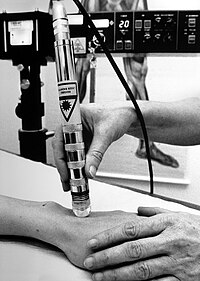
Photo from wikipedia
Monocytes (Mos)/macrophages (Mϕs) orchestrate biological processes critical for efficient skin wound healing. However, current understanding of skin wound Mo/Mϕ heterogeneity is limited by traditional experimental approaches such as flow cytometry… Click to show full abstract
Monocytes (Mos)/macrophages (Mϕs) orchestrate biological processes critical for efficient skin wound healing. However, current understanding of skin wound Mo/Mϕ heterogeneity is limited by traditional experimental approaches such as flow cytometry and immunohistochemistry. Therefore, we sought to more fully explore Mo/Mϕ heterogeneity and associated state transitions during the course of excisional skin wound healing in mice using single-cell RNA sequencing. The live CD45+CD11b+Ly6G- cells were isolated from skin wounds of C57BL/6 mice on days 3, 6, and 10 postinjury and captured using the 10x Genomics Chromium platform. A total of 2813 high-quality cells were embedded into a uniform manifold approximation and projection space, and eight clusters of distinctive cell populations were identified. Cluster dissimilarity and differentially expressed gene analysis categorized those clusters into three groups: early-stage/proinflammatory, late-stage/prohealing, and Ag-presenting phenotypes. Signature gene and Gene Ontology analysis of each cluster provided clues about the different functions of the Mo/Mϕ subsets, including inflammation, chemotaxis, biosynthesis, angiogenesis, proliferation, and cell death. Quantitative PCR assays validated characteristics of early- versus late-stage Mos/Mϕs inferred from our single-cell RNA sequencing dataset. Additionally, cell trajectory analysis by pseudotime and RNA velocity and adoptive transfer experiments indicated state transitions between early- and late-state Mos/Mϕs as healing progressed. Finally, we show that the chemokine Ccl7, which was a signature gene for early-stage Mos/Mϕs, preferentially induced the accumulation of proinflammatory Ly6C+F4/80lo/- Mos/Mϕs in mouse skin wounds. In summary, our data demonstrate the complexity of Mo/Mϕ phenotypes, their dynamic behavior, and diverse functions during normal skin wound healing.
Journal Title: Journal of immunology
Year Published: 2022
Link to full text (if available)
Share on Social Media: Sign Up to like & get
recommendations!